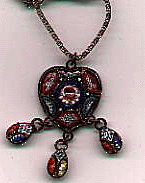"SHAWNEE SILVER"
MYSTERY AND INTRIGUE

"My Great-grandmother's Necklace"
This necklace was made for my great-grandmother by her grandfather. I would love to know what the stones are and how they stay in the necklace. They are tiny shaved pieces of blue, red, yellow, white, pink, orange and black. The necklace is made of silver.
The source of the Shawnee silver, of which there was a considerable abundance, has always been a matter of mystery and intrigue. There is no doubt whatever that the Shawnee did have access to a large and continuing supply of raw silver and there is no evidence of such ore ever having been transported into the Shawnee territory from elsewhere.
There is much romantic folklore about the so-called "lost Shawnee silver mines," most of which is rather ridiculous, but enough truth exists in the record as to be intriguing.
Such mines, if they existed, are believed to have been located in present Warren and Green counties in Ohio, such reports based on the accounts of various white men who had been held captive at Chalahgawtha and were forced to carry ore to the village for smelting and working. These prisoners were marched, always blindfolded, for what seemed to them a few hours ( but which was probably less ) upstream along the course of Massies Creek to some location in the Clifton Gorge area, from just behind present Wilberforce University to "The Glenn" in the present village of Yellow Springs. At a certain point the prisoners were ordered to sit and wait under guard until they were laden with heavy sacks of what they believed to be silver-bearing ore, which they were compelled to carry back to Chalahgawtha. Some attempts to slip the blindfolds were, to a limited extent, successful.
With a map or two of "mine locations," this general area is well described by Dr. Roy S. King, University of Arizona, in an interesting paper entitled "Silver Mines of the Ohio Indians," in the Ohio Archaeological and Historical Quarterly, XXVI (1917), 114-116. For many years after their removal to the Auglaize Reservation, small parties of Shawnees returned every summer to Greene Co. and stopped for a few days of camping in "The Glen" at Yellow Springs, now a part of the campus of Antioch University. They then passed onward to the location given in Professor King's paper and from there to well-marked locations in Warren Co. along Caesar Creek near present Harveysburg, where excavations ( made before the advent of white pioneers) were discovered by the earliest arriving settlers.
Virtually all of this area has now been covered over by the U.S. Corps of Engineers impoundment called Caesar Creek Lake. Early excavations of two similar excavations found in the glen at Yellow Springs showed vertical shafts with evidence of timbering in one of them. Excavation evidence at one site is still vaguely apparent. Geological surveys state that the Clifton limestone formation outcropping in this glen as well as the nearby Clifton Gorge, is not ore-bearing. Yet, William Albert Galloway (lineal descendent of James Galloway, first white settler in the Chalahgawtha area0, while he was a student at Antioch College, did some blasting in the gorge and uncovered a half-inch vein near the falls on the east end of Yellow Springs Creek, which runs through these grounds. The residue of some specimens from this vein were submitted to a competent assayer in Cincinnati and were found to contain a very definite bead of high-grade silver. Some decades ago an exploratory shaft in Clifton Gorge but no heavy deposit of silver was located and the shaft was abandoned and sealed off when it showed signs of collaping. Only a few years ago a geology student collecting rock samples in the gorge found several pieces of ore quite rich in silver content. The mother lode, if one exists, however, has never been located.
"Shawnee's Reservation"
"Homepage"
© 1997 shawnee_1@yahoo.com
This page hosted by  Get your own Free Home Page
Get your own Free Home Page
